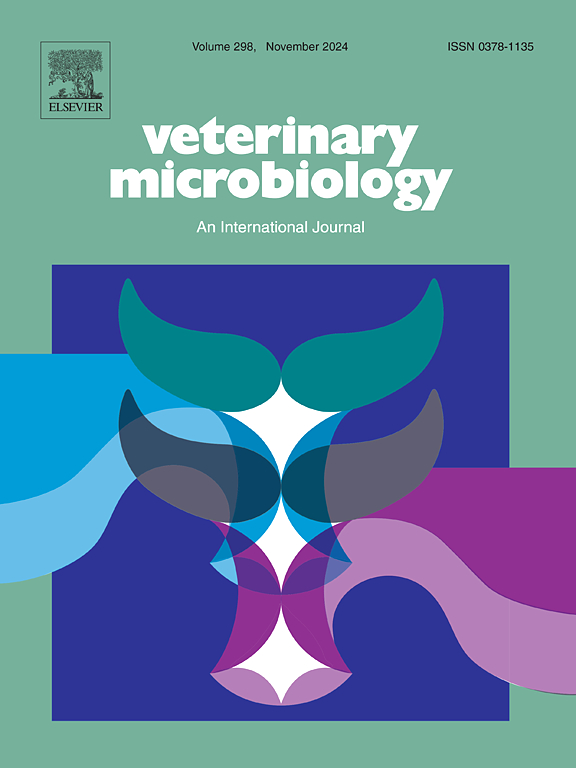抵御风暴:极端天气事件及其与 PED 和 PRRS 发生的关系。
IF 2.4
2区 农林科学
Q3 MICROBIOLOGY
引用次数: 0
摘要
猪流行性腹泻 (PED) 和猪繁殖与呼吸综合征 (PRRS) 是持续挑战美国养猪业的病毒性疾病。尽管有许多已知的风险因素,但与这两种疾病发生相关的异常情况仍然没有得到很好的解释。我们采用病例对照研究和逻辑回归模型来控制协变量,调查了极端天气事件(洪水、暴雨、大风和龙卷风,以县为单位测量)是否与天气事件发生后十周内这两种疾病的发生有关。我们从莫里森猪健康监测项目(MSHMP)中获得了每周农场级别的疾病发生信息,从美国国家海洋和大气管理局(NOAA)风暴事件数据库中获得了县级天气事件发生信息。我们的研究结果表明,与对照农场相比,遭受洪水侵袭的县级农场在洪水过后四到八周内爆发 PED 的几率要高出两到三倍。然而,我们并未观察到其他天气事件与 PED 或 PRRS 发生之间存在明显关联。尽管这些事件对猪群造成的绝对风险可能很小,但我们建议公司应制定考虑极端天气事件影响的生物安全协议,以降低对猪群造成的风险。本文章由计算机程序翻译,如有差异,请以英文原文为准。
Weathering the storm: Extreme weather events and their association with PED and PRRS occurrence
Porcine epidemic diarrhea (PED) and Porcine reproductive and respiratory syndrome (PRRS) are viral diseases that continue to challenge the US swine industry. Despite many known risk factors, unusual circumstances associated with their occurrence continues to be poorly explained. We investigated if extreme weather events (flood, heavy rain, high wind and tornadoes, measured at a county-level) are associated with the occurrence of both diseases up to ten weeks after the occurrence of the weather event using a case control study and logistic regression modeling to control for covariates. We obtained weekly farm-level disease occurrence information from the Morrison Swine Health Monitoring Project (MSHMP) and county-level weather events occurrence information from the National Oceanic and Atmospheric Administration (NOAA) storm events database. Our findings indicate that farms in counties exposed to floods had between two to three times higher odds of experiencing a PED outbreak between four to eight weeks after the event than control farms. However, we did not observe significant associations between other weather events and PED or PRRS occurrences. Even though the absolute risk these events pose to swine herds may be small, we suggest that companies should develop biosecurity protocols that consider the impact of extreme weather events in order to mitigate the risks posed to their herds.
求助全文
通过发布文献求助,成功后即可免费获取论文全文。
去求助
来源期刊

Veterinary microbiology
农林科学-兽医学
CiteScore
5.90
自引率
6.10%
发文量
221
审稿时长
52 days
期刊介绍:
Veterinary Microbiology is concerned with microbial (bacterial, fungal, viral) diseases of domesticated vertebrate animals (livestock, companion animals, fur-bearing animals, game, poultry, fish) that supply food, other useful products or companionship. In addition, Microbial diseases of wild animals living in captivity, or as members of the feral fauna will also be considered if the infections are of interest because of their interrelation with humans (zoonoses) and/or domestic animals. Studies of antimicrobial resistance are also included, provided that the results represent a substantial advance in knowledge. Authors are strongly encouraged to read - prior to submission - the Editorials (''Scope or cope'' and ''Scope or cope II'') published previously in the journal. The Editors reserve the right to suggest submission to another journal for those papers which they feel would be more appropriate for consideration by that journal.
Original research papers of high quality and novelty on aspects of control, host response, molecular biology, pathogenesis, prevention, and treatment of microbial diseases of animals are published. Papers dealing primarily with immunology, epidemiology, molecular biology and antiviral or microbial agents will only be considered if they demonstrate a clear impact on a disease. Papers focusing solely on diagnostic techniques (such as another PCR protocol or ELISA) will not be published - focus should be on a microorganism and not on a particular technique. Papers only reporting microbial sequences, transcriptomics data, or proteomics data will not be considered unless the results represent a substantial advance in knowledge.
Drug trial papers will be considered if they have general application or significance. Papers on the identification of microorganisms will also be considered, but detailed taxonomic studies do not fall within the scope of the journal. Case reports will not be published, unless they have general application or contain novel aspects. Papers of geographically limited interest, which repeat what had been established elsewhere will not be considered. The readership of the journal is global.
 求助内容:
求助内容: 应助结果提醒方式:
应助结果提醒方式:


